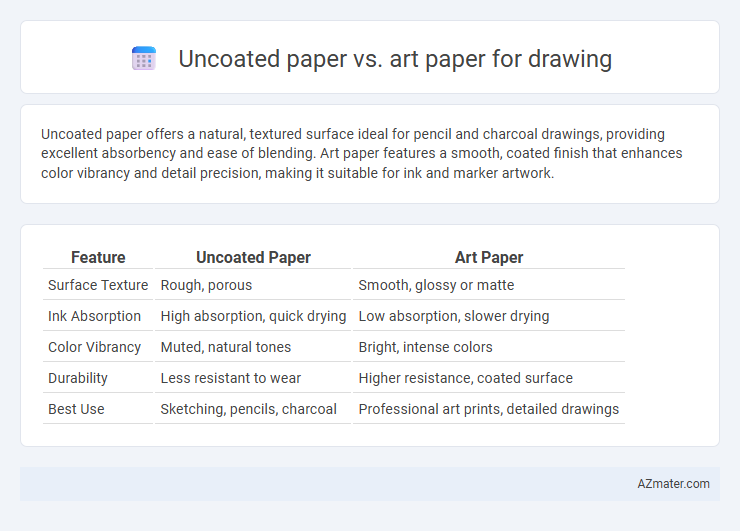Uncoated paper offers a natural, textured surface ideal for pencil and charcoal drawings, providing excellent absorbency and ease of blending. Art paper features a smooth, coated finish that enhances color vibrancy and detail precision, making it suitable for ink and marker artwork.
Table of Comparison
| Feature | Uncoated Paper | Art Paper |
|---|---|---|
| Surface Texture | Rough, porous | Smooth, glossy or matte |
| Ink Absorption | High absorption, quick drying | Low absorption, slower drying |
| Color Vibrancy | Muted, natural tones | Bright, intense colors |
| Durability | Less resistant to wear | Higher resistance, coated surface |
| Best Use | Sketching, pencils, charcoal | Professional art prints, detailed drawings |
Introduction to Paper Types for Drawing
Uncoated paper and art paper represent two fundamental categories in drawing mediums, each offering distinct textures and absorbency levels that affect media application. Uncoated paper, often rougher and porous, excels with dry media like pencils and charcoal due to its ability to grip particles, while art paper, typically coated and smoother, enhances the vibrancy and precision of ink and markers. Understanding these characteristics aids artists in selecting the appropriate surface to optimize detail, color intensity, and overall artwork durability.
What Is Uncoated Paper?
Uncoated paper is a versatile, porous sheet without a glossy or sealed surface, allowing it to absorb ink and pencil marks effectively for detailed drawing and sketching. Unlike art paper, which is often smooth and coated to enhance color vibrancy and prevent ink spread, uncoated paper provides a natural texture ideal for pencils, charcoal, and pastels. Its ability to hold fine details and produce rich, varied line quality makes uncoated paper a preferred choice for artists focusing on traditional drawing techniques.
What Is Art Paper?
Art paper, typically coated with a smooth or glossy finish, enhances color vibrancy and detail in drawings by preventing ink or pigment absorption. Uncoated paper, in contrast, offers a textured surface that absorbs media, creating softer, more muted effects ideal for sketching or detailed pencil work. Artists select art paper for its ability to produce sharp lines and rich colors, making it suitable for fine art prints, illustrations, and mixed media projects.
Surface Texture: Uncoated vs Art Paper
Uncoated paper features a rough, porous surface that absorbs ink and pigment, enhancing texture and grip for pencil and charcoal drawings. Art paper typically has a smooth, coated finish that allows for vibrant color reproduction and detailed line work, ideal for markers and fine liners. The choice between uncoated and art paper depends on the desired drawing technique and the level of detail required.
Absorption and Medium Compatibility
Uncoated paper offers high absorbency, making it ideal for dry media like graphite, charcoal, and colored pencils, as it allows for better layering and blending. Art paper, particularly coated varieties, has a less absorbent surface that prevents ink and paint from spreading, ensuring crisp lines for wet media such as markers, watercolors, and acrylics. Choosing between uncoated and art paper depends on the medium used: uncoated supports dry techniques with deeper pigment absorption, while coated art paper enhances the vibrancy and precision of wet applications.
Color Reproduction and Vibrancy
Uncoated paper offers a matte surface that absorbs ink quickly, resulting in softer color reproduction suitable for subtle shading but less vibrant tones. Art paper, with its coated finish, enhances color vibrancy by reflecting light and preventing ink absorption, making colors appear richer and more saturated for dynamic drawings. Artists seeking intense, vivid color effects prefer art paper, while those favoring a natural, textured look choose uncoated paper for its muted yet detailed color rendition.
Durability and Archival Quality
Uncoated paper offers superior durability and is less prone to yellowing over time due to its natural fibers and absence of coatings, making it ideal for archival-quality drawings. Art paper, often coated to enhance brightness and smoothness, may degrade faster under exposure to light and environmental factors, reducing its longevity for archival purposes. For artists prioritizing long-term preservation, uncoated paper provides a more stable and enduring surface that maintains the integrity of the artwork.
Cost Considerations
Uncoated paper typically costs less than art paper due to its simpler manufacturing process and lack of coating, making it a budget-friendly choice for sketching and preliminary drawings. Art paper, often coated with clay or plastic, results in higher production expenses and thus a higher price, but it offers superior smoothness and color vibrancy ideal for finished artwork. Choosing between uncoated and art paper depends on balancing initial cost savings against desired texture and color quality for the drawing project.
Best Uses for Uncoated Paper
Uncoated paper is ideal for pencil, charcoal, and pastel drawings due to its textured surface that enhances grip and blending. It absorbs ink and pigment well, making it perfect for detailed sketches and fine line work without smudging. Artists prefer uncoated paper for its natural feel and versatility in mixed-media applications.
Best Uses for Art Paper
Art paper offers a smooth, glossy surface ideal for vibrant, detailed drawings with ink, markers, or colored pencils, enhancing color intensity and sharpness. Its coated finish prevents ink absorption, reducing smudging and allowing for precise line work and layering techniques. Best suited for fine art prints, posters, and professional illustrations, art paper elevates visual impact where texture and color brilliance are paramount.

Infographic: Uncoated paper vs Art paper for Drawing
 azmater.com
azmater.com